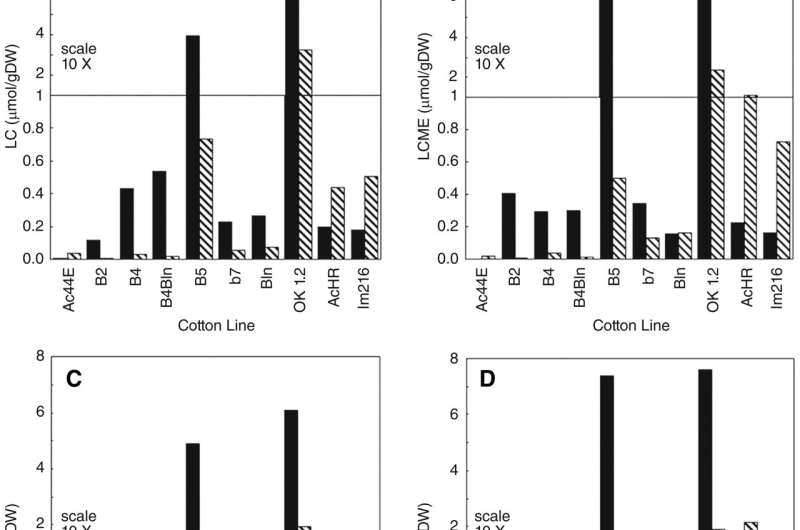This article has been reviewed according to Science X's editorial process and policies. Editors have highlighted the following attributes while ensuring the content's credibility:
fact-checked
proofread
Gene grants powerful resistance to resurging plant disease

While wrapping oneself in 100% Egyptian cotton bedsheets is a delightful luxury on a warm summer night, cotton provides much more than breathable, soft fabric. In addition to textiles, the cotton plant is grown for food, fuel, and daily-use consumer products—such as coffee filters, currency, and moisturizers. However, a resurging plant disease called bacterial blight is currently threatening cotton production worldwide.
Bacterial blight is best controlled through natural, genetic resistance. Although several genes for natural resistance to bacterial blight of cotton were discovered in northeast Africa during the mid-twentieth century, one of these genes, found in Egyptian cotton, had been overlooked until a team of researchers led by Margaret Essenberg from Oklahoma State University began studying the gene.
One of their recent studies, published in Phytopathology, unveiled that gene B5 confers powerful resistance to bacterial blight.
Essenberg and colleagues observed puzzling behavior from gene B5after it was crossed into the DNA of upland cotton—a variety used in most clothing fabrics—as it did not appear to follow typical Mendelian genetics. Further investigation revealed an explanation for this peculiarity: upland cotton (AcB5) appears to carry gene B5 at two locations in its genome versus the typical single location.
Under Oklahoma field conditions, the gene at either location enabled strong resistance to bacterial blight. In the lab, AcB5 exhibited resistance to the predominant and widely virulent strain of the disease's causal pathogen, race 18, in addition to nine other pathogen races.
These findings have positive implications for bacterial blight resistance in agriculture. "Natural, heritable disease resistance is an economical and environmentally safe means of maintaining plant health," corresponding author Melanie Bayles explains. "Resistance genes trigger synthesis of natural defense chemicals at sites of infection. AcB5 cotton is a champion in this activity; it accumulated at least ten-fold more defense chemicals than cotton lines with four other single resistance genes."
Because pathogens often evolve to overcome such resistance, relying only on a single gene for disease resistance is precarious. The researchers propose that plant breeders combine this valuable B5 gene with other strong, broadly specific genes, such as B12, to develop durable resistance to bacterial blight.
In addition to plant breeding, Bayles states that this research can benefit disciplines such as molecular plant-microbe interactions and phytochemistry, since the "signal transduction pathways of five different major genes for bacterial disease resistance in cotton are shown to lead in part to production of the same set of defense chemicals." AcB5 is available for other researchers to use, along with a near-isogenic susceptible parent line.
Essenberg and colleagues' new, quick method for estimating amounts of defense chemicals in cotton plants offers a "blight bulb" idea for improving resistance to this prevalent disease.
More information: Margaret Essenberg et al, Gene B5 in Cotton Confers High and Broad Resistance to Bacterial Blight and Conditions High Amounts of Sesquiterpenoid Phytoalexins, Phytopathology (2023). DOI: 10.1094/PHYTO-08-22-0310-FI
Provided by American Phytopathological Society




















